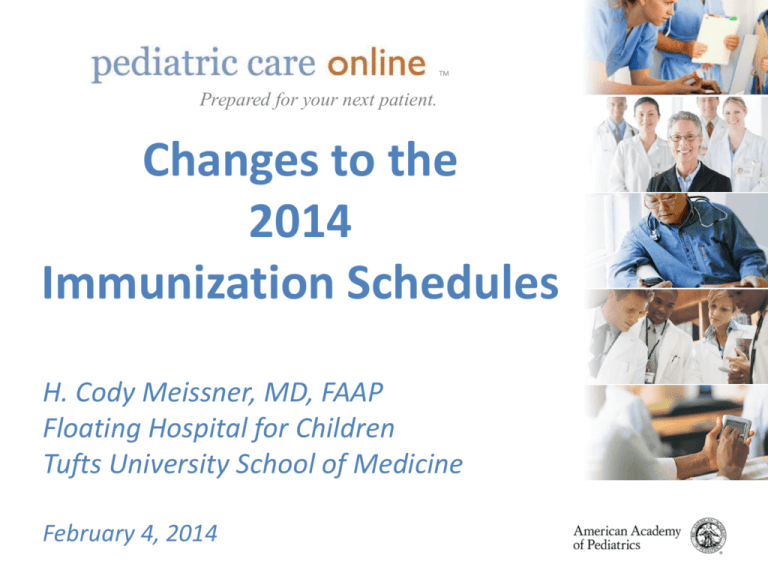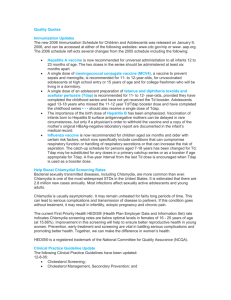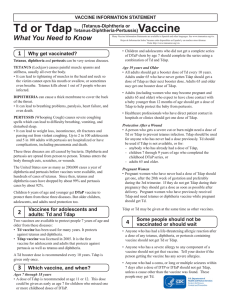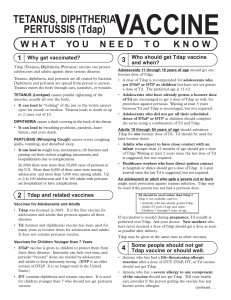PPT - American Academy of Pediatrics
advertisement

TM TM Prepared for your next patient. Changes to the 2014 Immunization Schedules H. Cody Meissner, MD, FAAP Floating Hospital for Children Tufts University School of Medicine February 4, 2014 TM Disclaimers I have no relevant financial relationships with the manufacturer(s) of any commercial product(s) discussed in this presentation. I may discuss the use of vaccines in a manner not consistent with the Package Insert, but all recommendations are in accordance with recommendations from the Advisory Committee on Immunization Practices (ACIP) and American Academy of Pediatrics (AAP). Statements and opinions expressed are those of the authors and not necessarily those of the AAP. TM TM Title TM Meningococcal Disease Incidence 1970-2012 1970-1996 NNDSS data, 1997-2012 ABCs data estimated to U.S. population TM Meningococcal Vaccines Quadrivalent polysaccharide vaccine o MPSV4 (Menomune, Sanofi Pasteur) Conjugate vaccines o MenACWY-D (Menactra, Sanofi Pasteur) • Approved for 9 months through 55 years o MenACWY-CRM (Menveo, Novartis) • Approved for 2 months through 55 years o HibMenCY-TT (MenHibRix, GlaxoSmithKline) • Approved for infants at 2 through 18 months TM Infant Meningococcal Vaccines: Number Needed to Vaccinate (NNV) Meningococcal incidence (Year Range Data) Cases prevented (4 dose infant series) Deaths Prevented NNV to prevent one case NNV to prevent one death High Incidence (1997-1999) 307 20-30 11,000 127,000 Base-case (1993-2009) 135 5-10 25,000 325,000 Low Incidence (2007-2009) 44 2-4 76,000 642,000 Data from Ortega-Sanchez CE model, presented at ACIP, October 2011 Infant and Toddler Meningococcal Vaccines for High Risk Children TM TM Bordetella pertussis Major Antigens and Virulence Factors Pertussis toxin (PT), also known as lymphocytosispromoting factor (LPF) Filamentous hemagglutinin (FHA) Pertactin (PRN), also known as 69 kilodalton protein Fimbrial agglutinogens (FIM) TM Pertussis Deaths, United States, 2000-2009 TM Current Recommendations for Tdap Adolescents aged 11 through 18 years, preferred at 11 or 12 years o Adults aged 19 and older o Special focus on adults in contact with young children • • • • Pregnant women Healthcare professionals Parents and siblings Grandparents (including those >65 years of age o The modest impact and short duration of protection from Tdap does not support a recommendation for 2nd dose Decennial Td booster for those who have received 1 Tdap o 5 years for wound management TM Tdap Recommendations for Pregnant Women Administer Tdap to pregnant adolescents and adults during each pregnancy o Regardless of number of years since prior Td or Tdap o Preferably during 27-36 weeks’ gestation o Additional doses not recommended for fathers or other family members/caregivers If not administered during pregnancy, Tdap should be administered immediately postpartum if no previous Tdap TM Human Papillomaviruses (HPV) Double stranded DNA virus o More than 130 closely related viruses o Types numbered in order of discovery (L1) o Classified as low risk (non-oncogenic) or high-risk (oncogenic) Almost all males and females will be infected at least once in their lifetime o Most people not aware when infected o Necessary but not sufficient for development of cancer Estimate 79 million Americans currently HPV infected o Most common sexually transmitted pathogen in males and females o 6.2 million new infections each year o 26,200 new HPV cancers each year TM ACIP Recommendations for HPV Vaccination Females o Routine: age 11 or 12 years o Catch-up: age 13 though 26 years o Either HPV4 or HPV2 is recommended Males o Routine: age 11 or 12 years o Catch-up: age 13 through 21 years age 22 through 26 years may be vaccinated o HPV4 is recommended Administer second dose 1-2 months after 1st dose and administer 3rd dose 6 months after 1st dose (at least 24 weeks after 1st dose) TM HPV Associated Cancers, both Sexes, 2005-2009 TM Adolescent Vaccine (13-17 Years Old), United States, 2006-2012 Centers for Disease Control and Prevention. National and State Vaccination Coverage Among Adolescents Aged 13–17 Years — United States, 2012. MMWR. 2013;62(34);685-693; NIS-Teen TM Prevalence of HPV 6, 11, 16, 18* in Cervicovaginal Swabs, By Age Group NHANES, 2003-2006 and 2007-2010 Markowitz LE, Hariri S, Lin C, et al. Reduction in human papillomavirus (HPV) prevalence among young women following HPV vaccine introduction in the United States, National Health and Nutrition Examination Surveys, 20032010. J Infect Dis. 2013;208(3):385-93 *weighted prevalence TM Vaccine Preventable Cervical Cancer Courtesy of National Cancer Institute TM Thank You Boston Floating Hospital, circa 1920 TM Visit Pediatric Care Online today for additional information on this and other topics. www.pediatriccareonline.org Pediatric Care Online is a convenient electronic resource for immediate expert help with virtually every pediatric clinical information need with musthave resources that are included in a comprehensive reference library and time-saving clinical tools.







